Effects of Trunk Distance and Rainfall on Throughfall and Associated Chemical Alterations within a Subtropical Deciduous Forest
Abstract
:1. Introduction
2. Materials and Methods
2.1. Site Description
2.2. Rainfall and Throughfall Field Measurements and Sampling
2.3. Chemical Analysis and Calculation
2.4. Statistical Analyses
3. Results
3.1. Characteristics of Rainfall and Throughfall during the Experimental Period
3.2. Element Concentrations of Rainfall and Throughfall
3.3. Throughfall and Associated Chemical Alterations in Relation to Trunk Distance
3.4. Throughfall and Associated Chemical Alterations in Relation to Rainfall Factors
4. Discussion
4.1. Throughfall and Chemical Alterations in Different Studies
4.2. Effect of Trunk Distance on Throughfall and Associated Chemical Alterations
4.3. Rainfall Factors That Influence Throughfall and Associated Chemical Alterations
4.4. Limitations of the Study
5. Conclusions and Further Research Directions
Supplementary Materials
Author Contributions
Funding
Data Availability Statement
Acknowledgments
Conflicts of Interest
References
- Hamilton, E.L.; Rowe, P.B. Rainfall Interception by Chaparral in California; State of California, Department of Natural Resources, Division of Forestry: Sacramento, CA, USA, 1949.
- Levia, D.F.; Frost, E.E. Variability of throughfall volume and solute inputs in wooded ecosystems. Prog. Phys. Geogr. Earth Environ. 2006, 30, 605–632. [Google Scholar] [CrossRef]
- Sadeghi, S.M.; Gordon, D.A.; Van Stan, J.T., II. A global synthesis of throughfall and stemflow hydrometeorology. In Precipitation Partitioning Byvegetation: A Global Synthesis; Van Stan, J.T., Gutmann, E.D., Friesen, J., Eds.; Springer: Cham, Switzerland, 2020; pp. 49–70. [Google Scholar]
- Molina, A.J.; Llorens, P.; Garcia-Estringana, P.; de Las Heras, M.M.; Cayuela, C.; Gallart, F.; Latron, J. Contributions of throughfall, forest and soil characteristics to near-surface soil water-content variability at the plot scale in a mountainous Mediterranean area. Sci. Total Environ. 2019, 647, 1421–1432. [Google Scholar] [CrossRef]
- Jiang, Z.Y.; Zhi, Q.Y.; Van Stan, J.T.; Zhang, S.Y.; Xiao, Y.H.; Chen, X.Y.; Yang, X.; Zhou, H.Y.; Hu, Z.M.; Wu, H.W. Rainfall partitioning and associated chemical alteration in three subtropical urban tree species. J. Hydrol. 2021, 603, 127109. [Google Scholar] [CrossRef]
- Jochheim, H.; Lüttschwager, D.; Riek, W. Stem distance as an explanatory variable for the spatial distribution and chemical conditions of stand precipitation and soil solution under beech (Fagus sylvatica L.) trees. J. Hydrol. 2022, 608, 127629. [Google Scholar] [CrossRef]
- Guswa, A.J.; Spence, C.M. Effect of throughfall variability on recharge: Application to hemlock and deciduous forests in western Massachusetts. Ecohydrology 2012, 5, 563–574. [Google Scholar] [CrossRef]
- Nanko, K.; Onda, Y.; Ito, A.; Moriwaki, H. Spatial variability of throughfall under a single tree: Experimental study of rainfall amount, raindrops, and kinetic energy. Agric. For. Meteorol. 2011, 151, 1173–1182. [Google Scholar] [CrossRef]
- Liu, Y.; Liu, S.; Wan, S.; Wang, J.; Wang, H.; Liu, K. Effects of experimental throughfall reduction and soil warming on fine root biomass and its decomposition in a warm temperate oak forest. Sci. Total Environ. 2017, 574, 1448–1455. [Google Scholar] [CrossRef] [Green Version]
- Lin, Y.; Kong, J.; Yang, L.; He, Q.; Su, Y.; Li, J.; Wang, G.; Qiu, Q. Soil Bacterial and Fungal Community Responses to Throughfall Reduction in a Eucalyptus Plantation in Southern China. Forests 2021, 13, 37. [Google Scholar] [CrossRef]
- Wang, Y.; Liu, S.; Luan, J.; Chen, C.; Cai, C.; Zhou, F.; Di, Y.; Gao, X. Nitrogen Addition Exacerbates the Negative Effect of Throughfall Reduction on Soil Respiration in a Bamboo Forest. Forests 2021, 12, 724. [Google Scholar] [CrossRef]
- Beier, C.; Hansen, K.; Gundersen, P. Spatial variability of throughfall fluxes in a spruce forest. Environ. Pollut. 1993, 81, 257–267. [Google Scholar] [CrossRef]
- Seiler, J.; Matzner, E. Spatial variability of throughfall chemistry and selected soil properties as influenced by stem distance in a mature Norway spruce (Picea abies, Karst.) stand. Plant Soil 1995, 176, 139–147. [Google Scholar] [CrossRef]
- Pedersen, L.B. Throughfall chemistry of Sitka spruce stands as influenced by tree spacing. Scand. J. For. Res. 1992, 7, 433–444. [Google Scholar] [CrossRef]
- Hansen, K. In-canopy throughfall measurements of ion fluxes in Norway spruce. Atmos. Environ. 1996, 30, 4065–4076. [Google Scholar] [CrossRef]
- Yue, K.; De Frenne, P.; Fornara, D.A.; Van Meerbeek, K.; Li, W.; Peng, X.; Ni, X.; Peng, Y.; Wu, F.; Yang, Y.; et al. Global patterns and drivers of rainfall partitioning by trees and shrubs. Glob. Chang. Biol. 2021, 27, 3350–3357. [Google Scholar] [CrossRef]
- De Schrijver, A.; Geudens, G.; Augusto, L.; Staelens, J.; Mertens, J.; Wuyts, K.; Gielis, L.; Verheyen, K. The effect of forest type on throughfall deposition and seepage flux: A review. Oecologia 2007, 153, 663–674. [Google Scholar] [CrossRef] [PubMed]
- Adriaenssens, S.; Hansen, K.; Staelens, J.; Wuyts, K.; De Schrijver, A.; Baeten, L.; Boeckx, P.; Samson, R.; Verheyen, K. Throughfall deposition and canopy exchange processes along a vertical gradient within the canopy of beech (Fagus sylvatica L.) and Norway spruce (Picea abies (L.) Karst). Sci. Total Environ. 2012, 420, 168–182. [Google Scholar] [CrossRef]
- Kowalska, A.; Boczoń, A.; Hildebrand, R.; Polkowska, Ż. Spatial variability of throughfall in a stand of Scots pine (Pinus sylvestris L.) with deciduous admixture as influenced by canopy cover and stem distance. J. Hydrol. 2016, 538, 231–242. [Google Scholar] [CrossRef]
- Hansen, K. In-canopy throughfall measurements in Norway spruce: Water flow and consequences for ion fluxes. Water Air Soil Pollut. 1995, 85, 2259–2264. [Google Scholar] [CrossRef]
- Sun, X.; Onda, Y.; Kato, H.; Gomi, T.; Liu, X. Estimation of throughfall with changing stand structures for Japanese cypress and cedar plantations. For. Ecol. Manag. 2017, 402, 145–156. [Google Scholar] [CrossRef]
- Zhang, H.X.; Wu, H.W.; Li, J.; He, B.; Liu, J.F.; Wang, N.; Duan, W.L.; Liao, A.M. Spatial-temporal variability of throughfall in a subtropical deciduous forest from the hilly regions of eastern China. J. Mt. Sci. 2019, 16, 1788–1801. [Google Scholar] [CrossRef]
- Sheng, H.; Cai, T. Spatial Variability of Throughfall in a Larch (Larix gmelinii) Forest in Great Kingan Mountain, Northeastern China. Forests 2021, 12, 393. [Google Scholar] [CrossRef]
- Ding, W.; Wang, F.; Han, J.; Ge, W.; Cong, C.; Deng, L. Throughfall and its spatial heterogeneity in a black locust (Robinia pseudoacacia) plantation in the semi-arid loess region, China. J. Hydrol. 2021, 602, 126751. [Google Scholar] [CrossRef]
- Magliano, P.N.; Whitworth-Hulse, J.I.; Florio, E.L.; Aguirre, E.C.; Blanco, L.J. Interception loss, throughfall and stemflow by Larrea divaricata: The role of rainfall characteristics and plant morphological attributes. Ecol. Res. 2019, 34, 753–764. [Google Scholar] [CrossRef]
- Hsueh, Y.; Allen, S.T.; Keim, R.F. Fine-scale spatial variability of throughfall amount and isotopic composition under a hardwood forest canopy. Hydrol. Processes 2016, 30, 1796–1803. [Google Scholar] [CrossRef]
- Bialkowski, R.; Buttle, J.M. Stemflow and throughfall contributions to soil water recharge under trees with differing branch architectures. Hydrol. Processes 2015, 29, 4068–4082. [Google Scholar] [CrossRef]
- Sun, X.; Onda, Y.; Chiara, S.; Kato, H.; Gomi, T. The effect of strip thinning on spatial and temporal variability of throughfall in a Japanese cypress plantation. Hydrol. Processes 2015, 29, 5058–5070. [Google Scholar] [CrossRef]
- Kato, H.; Onda, Y.; Nanko, K.; Gomi, T.; Yamanaka, T.; Kawaguchi, S. Effect of canopy interception on spatial variability and isotopic composition of throughfall in Japanese cypress plantations. J. Hydrol. 2013, 504, 1–11. [Google Scholar] [CrossRef]
- Mululo Sato, A.; de Souza Avelar, A.; Coelho Netto, A.L. Spatial variability and temporal stability of throughfall in a eucalyptus plantation in the hilly lowlands of southeastern Brazil. Hydrol. Processes 2011, 25, 1910–1923. [Google Scholar] [CrossRef]
- Cao, Y.; Ouyang, Z.Y.; Zheng, H.; Huang, Z.G.; Wang, X.K.; Miao, H. Effects of forest plantations on rainfall redistribution and erosion in the red soil region of Southern China. Land Degrad. Dev. 2008, 19, 321–330. [Google Scholar] [CrossRef]
- Shachnovich, Y.; Berliner, P.R.; Bar, P. Rainfall interception and spatial distribution of throughfall in a pine forest planted in an arid zone. J. Hydrol. 2008, 349, 168–177. [Google Scholar] [CrossRef]
- Keim, R.F.; Skaugset, A.E.; Weiler, M. Temporal persistence of spatial patterns in throughfall. J. Hydrol. 2005, 314, 263–274. [Google Scholar] [CrossRef]
- Carlyle-Moses, D.E.; Laureano, J.S.F.; Price, A.G. Throughfall and throughfall spatial variability in Madrean oak forest communities of northeastern Mexico. J. Hydrol. 2004, 297, 124–135. [Google Scholar] [CrossRef]
- Loescher, H.W.; Powers, J.S.; Oberbauer, S.F. Spatial variation of throughfall volume in an old-growth tropical wet forest, Costa Rica. J. Trop. Ecol. 2002, 18, 949. [Google Scholar] [CrossRef]
- Whelan, M.J.; Sanger, L.J.; Baker, M.; Anderson, J.M. Spatial patterns of throughfall and mineral ion deposition in a lowland Norway spruce (Picea abies) plantation at the plot scale. Atmos. Environ. 1998, 32, 3493–3501. [Google Scholar] [CrossRef]
- Loustau, D.; Berbigier, P.; Granier, A.; Moussa, F.E. Interception loss, throughfall and stemflow in a maritime pine stand. I. Variability of throughfall and stemflow beneath the pine canopy. J. Hydrol. 1992, 138, 449–467. [Google Scholar] [CrossRef]
- Stout, B.B.; McMahon, R.J. Throughfall variation under tree crowns. J. Geophys. Res. 1961, 66, 1839–1843. [Google Scholar] [CrossRef]
- Tanaka, N.; Levia, D.; Igarashi, Y.; Nanko, K.; Yoshifuji, N.; Tanaka, K.; Tantasirin, C.; Suzuki, M.; Kumagai, T.O. Throughfall under a teak plantation in Thailand: A multifactorial analysis on the effects of canopy phenology and meteorological conditions. Int. J. Biometeorol. 2015, 59, 1145–1156. [Google Scholar] [CrossRef]
- Zabret, K.; Rakovec, J.; Šraj, M. Influence of meteorological variables on rainfall partitioning for deciduous and coniferous tree species in urban area. J. Hydrol. 2018, 558, 29–41. [Google Scholar] [CrossRef]
- Carlyle-Moses, D.E.; Lishman, C.E. Temporal persistence of throughfall heterogeneity below and between the canopies of juvenile lodgepole pine (Pinus contorta). Hydrol. Processes 2015, 29, 4051–4067. [Google Scholar] [CrossRef]
- Sun, X.; Zhang, Z.; Cao, Y.; Liu, L.; Hu, F.; Lu, X. Canopy modification of base cations deposition in a subtropical broadleaved forest: Spatial characteristics, canopy budgets and acid neutralizing capacity. For. Ecol. Manag. 2021, 482, 118863. [Google Scholar] [CrossRef]
- Yu, H.; He, N.; Wang, Q.; Zhu, J.; Xu, L.; Zhu, Z.; Yu, G. Wet acid deposition in Chinese natural and agricultural ecosystems: Evidence from national-scale monitoring. J. Geophys. Res. Atmos. 2016, 121, 10995–11005. [Google Scholar] [CrossRef]
- Zhang, H.; Levia, D.F.; He, B.; Wu, H.; Liao, A.; Carlyle-Moses, D.E.; Liu, J.; Wang, N.; Li, J.; Fu, C. Interspecific variation in tree- and stand-scale stemflow funneling ratios in a subtropical deciduous forest in eastern China. J. Hydrol. 2020, 590, 125455. [Google Scholar] [CrossRef]
- Gu, W.Z.; Liu, J.F.; Lu, J.J.; Frentress, J. Current Challenges in Experimental Watershed Hydrology. In Current Perspectives in Contaminant Hydrology and Water Resources Sustainability; Bradley, P.M., Ed.; InTech: Rijeka, Croatia, 2013. [Google Scholar]
- Han, C. Study on Rainfall Redistribution in Typical Forest Stands of Nanjing Suburbs. Master’s Thesis, Nanjing Forestry University, Nanjing China, 2014. (In Chinese). [Google Scholar]
- Lenz, A.K.; Bauer, U.; Ruxton, G.D. An ecological perspective on water shedding from leaves. J. Exp. Bot. 2022, 73, 1176–1189. [Google Scholar] [CrossRef] [PubMed]
- Kumar Gautam, M.; Lee, K.; Song, B.Y. Deposition pattern and throughfall fluxes in secondary cool temperate forest, South Korea. Atmos. Environ. 2017, 161, 71–81. [Google Scholar] [CrossRef]
- Tonello, K.C.; Rosa, A.G.; Pereira, L.C.; Matus, G.N.; Guandique, M.E.G.; Navarrete, A.A. Rainfall partitioning in the Cerrado and its influence on net rainfall nutrient fluxes. Agric. For. Meteorol. 2021, 303, 108372. [Google Scholar] [CrossRef]
- Van Stan, J.T., II; Levia, D.F., Jr.; Inamdar, S.P.; Lepori-Bui, M.; Mitchell, M.J. The effects of phenoseason and storm characteristics on throughfall solute washoff and leaching dynamics from a temperate deciduous forest canopy. Sci. Total Environ. 2012, 430, 48–58. [Google Scholar] [CrossRef] [PubMed]
- Robson, A.J.; Neal, C.; Ryland, G.P.; Harrow, M. Spatial variations in throughfall chemistry at the small plot scale. J. Hydrol. 1994, 158, 107–122. [Google Scholar] [CrossRef]

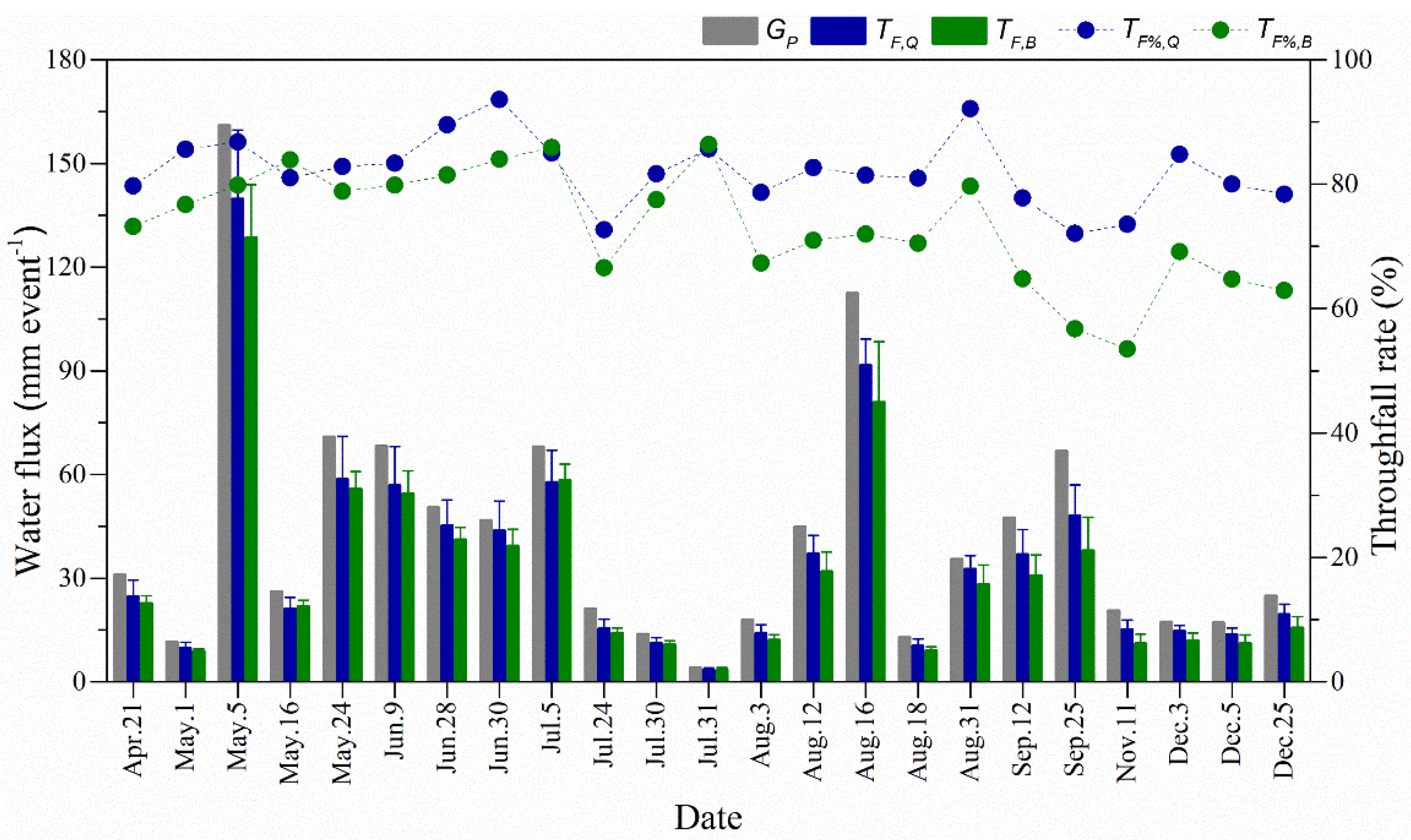
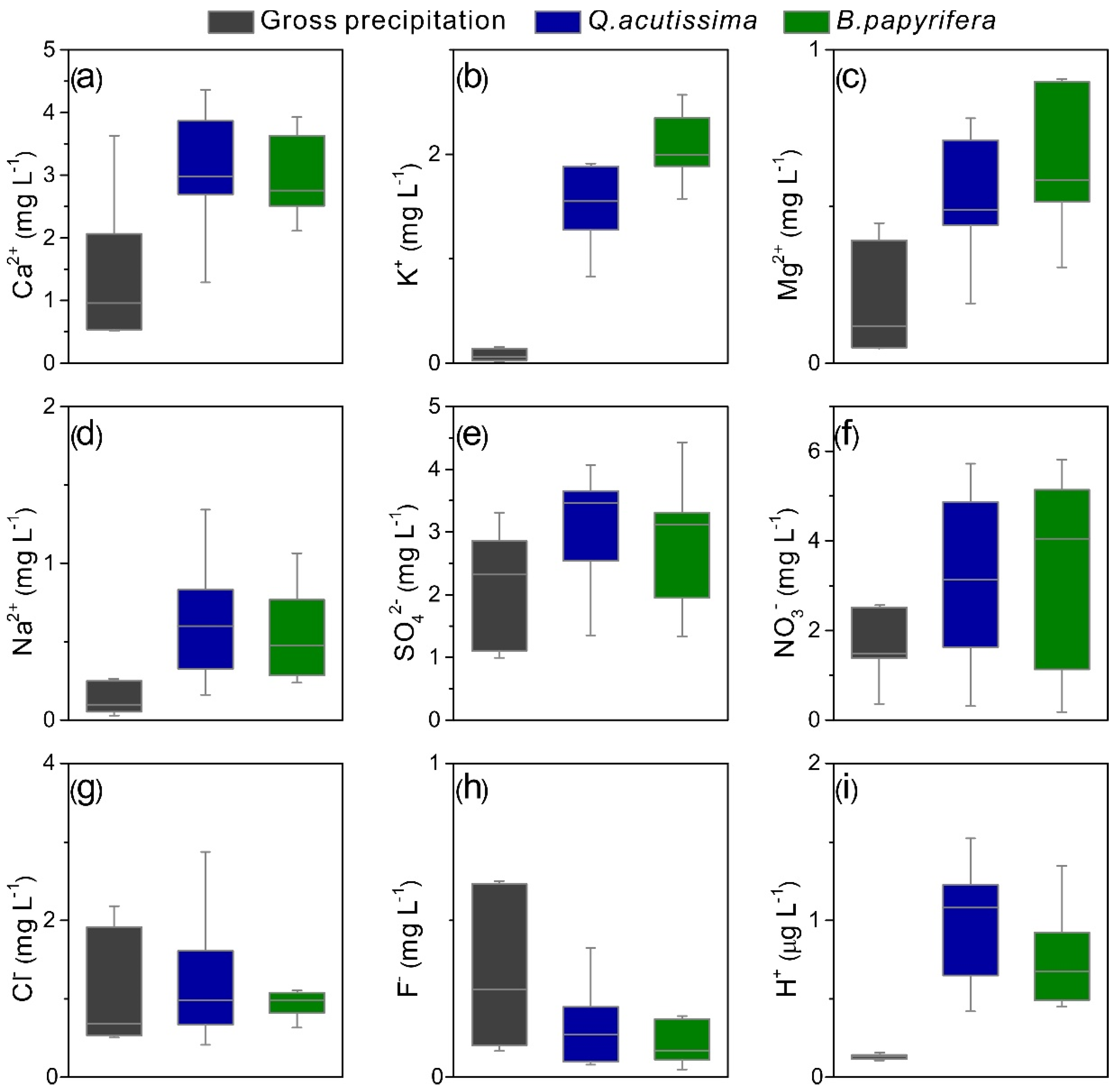
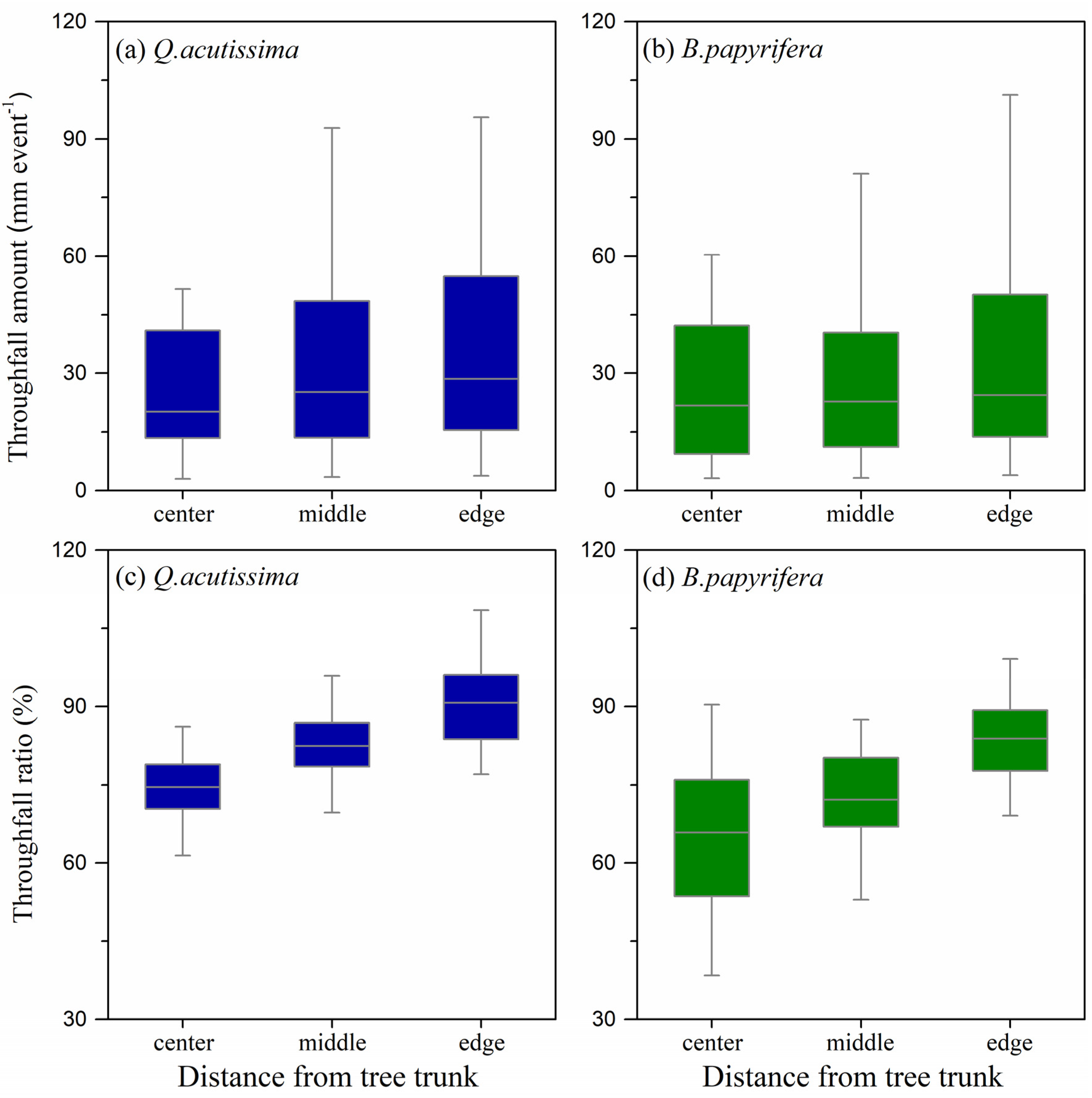
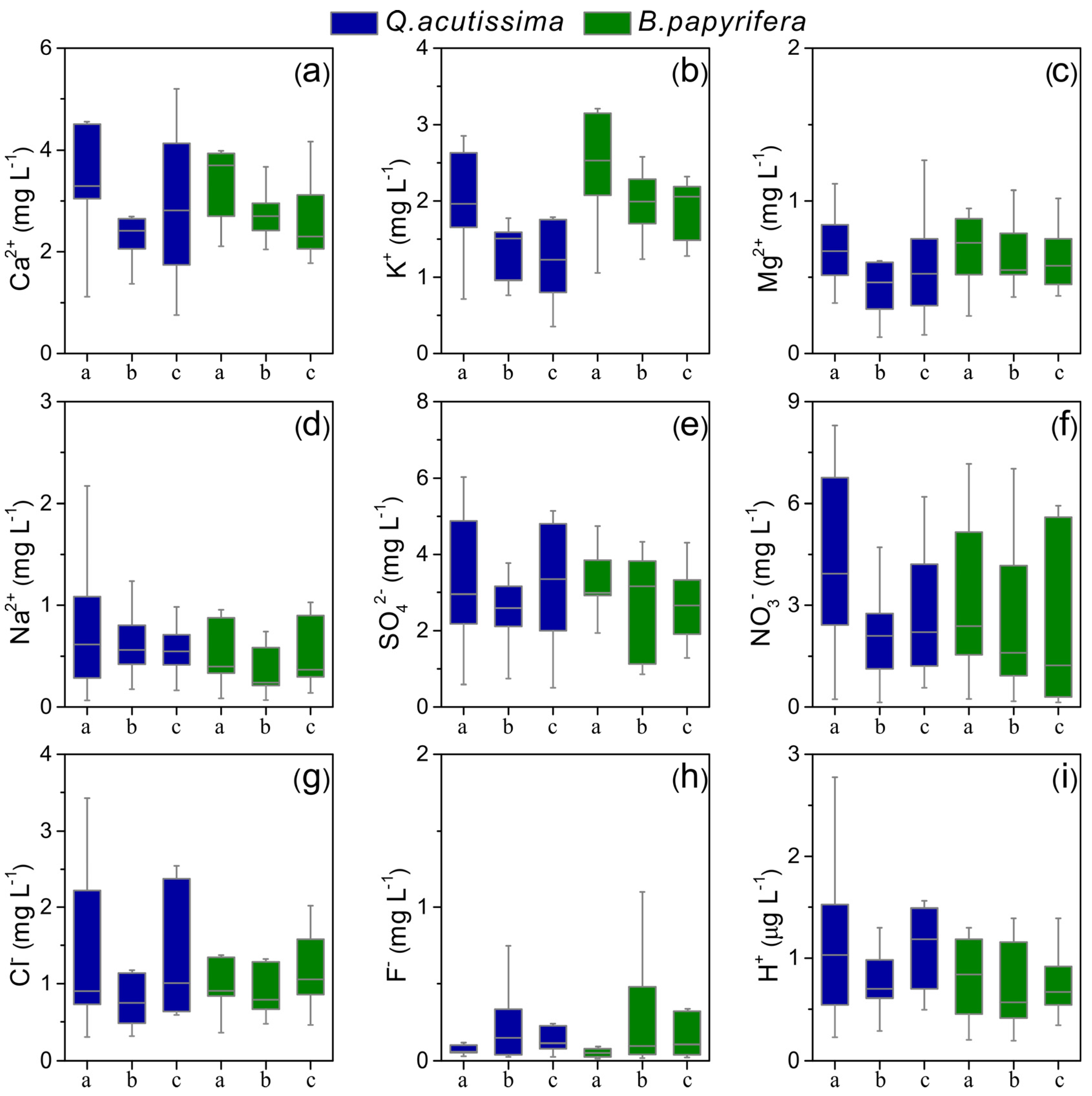
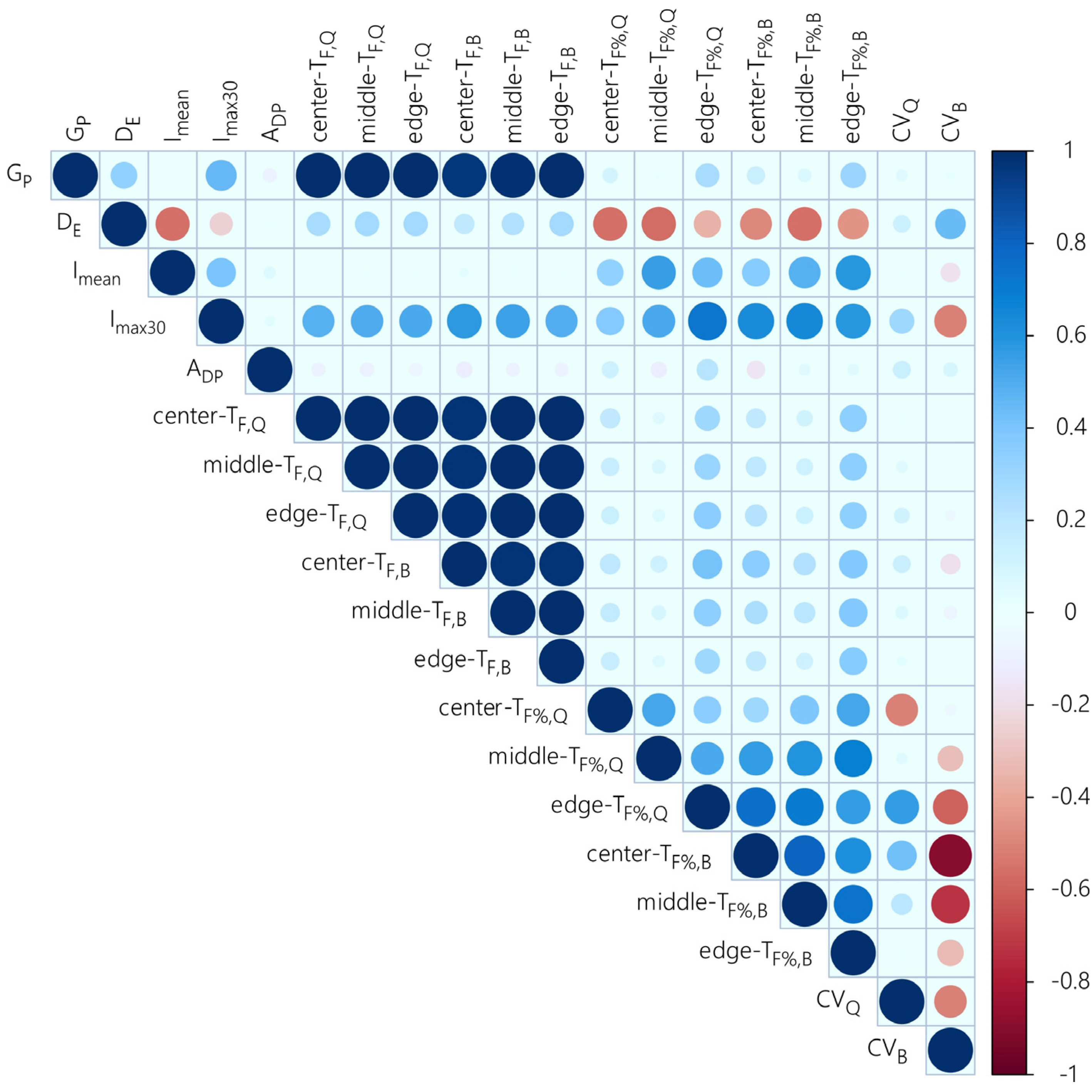
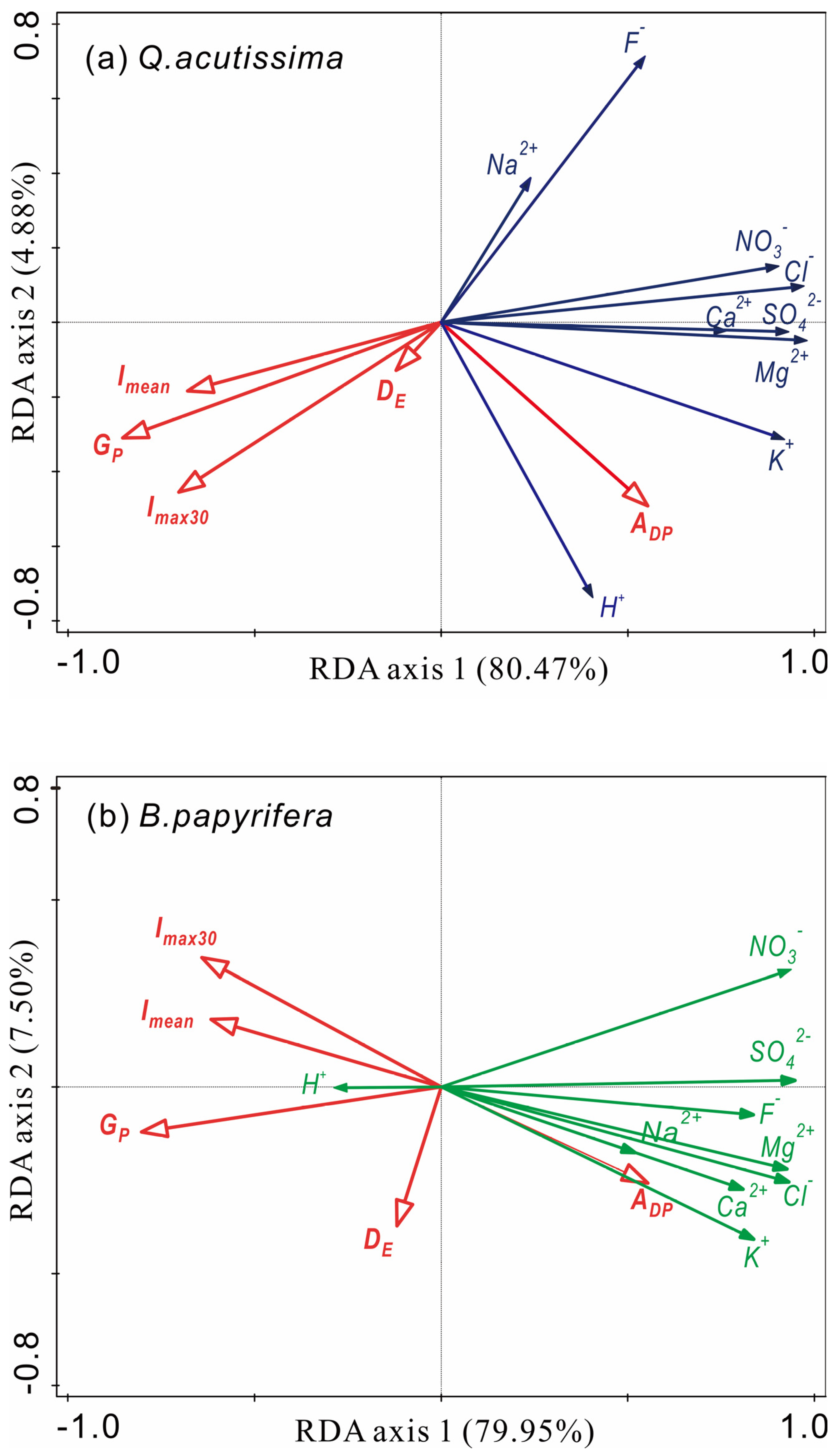
| Species | Tree NO. | Diameter at Breast Height (cm) | Basal Area (cm2) | Height (m) | Canopy Thickness (m) | Tree Lean (°) | Crown Area (m2) | Crown Length (m) | Leaf Surface/Area |
|---|---|---|---|---|---|---|---|---|---|
| Q. acutissima | Q1 | 14.9 | 174.4 | 22.1 | 14.4 | 19.8 | 8.4 | 2.72 | Smooth/ (12.3 ± 0.9) × (5.1 ± 0.6) cm |
| Q2 | 16 | 201.1 | 19.5 | 11.9 | 2.4 | 6.4 | 2.35 | ||
| Q3 | 19.1 | 286.6 | 20.1 | 15.4 | 2.5 | 23.6 | 3.29 | ||
| Q4 | 20.4 | 326.9 | 23.4 | 17.4 | 1 | 8.8 | 2.98 | ||
| Q5 | 22.8 | 408.3 | 22.4 | 15.4 | 7.9 | 32.6 | 4.43 | ||
| B. papyrifera | B1 | 13.1 | 134.8 | 17.2 | 10 | 16.3 | 9.7 | 3.59 | Rough/ (12.3 ± 1.2) × (7.7 ± 1.1) cm |
| B2 | 19.2 | 289.6 | 19.6 | 16.8 | 16.5 | 16.5 | 4.91 | ||
| B3 | 24.6 | 475.4 | 21.3 | 15.8 | 11.1 | 39.1 | 5.58 |
| Species | Ion | Enrichment Ratio of Throughfall | |||
|---|---|---|---|---|---|
| Mean | Center | Middle | Edge | ||
| Q. acutissima | Ca2+ | 3.49 ± 2.05 | 4.63 ± 4.27 | 3.02 ± 2.05 | 3.04 ± 2.08 |
| K+ | 29.31 ± 18.58 | 41.34 ± 35.32 | 26.80 ± 16.61 | 21.96 ± 13.30 | |
| Mg2+ | 5.43 ± 4.00 | 7.73 ± 5.74 | 4.48 ± 3.84 | 4.36 ± 3.19 | |
| Na2+ | 12.54 ± 18.45 | 15.50 ± 29.37 | 12.13 ± 16.90 | 10.55 ± 12.85 | |
| SO42− | 1.54 ± 0.78 | 1.87 ± 1.58 | 1.34 ± 0.56 | 1.43 ± 0.54 | |
| NO3− | 1.96 ± 1.31 | 2.77 ± 2.12 | 1.44 ± 1.12 | 1.78 ± 1.01 | |
| Cl− | 1.59 ± 1.00 | 1.85 ± 1.44 | 1.46 ± 1.31 | 1.49 ± 0.60 | |
| F− | 0.56 ± 0.45 | 0.40 ± 0.32 | 0.67 ± 0.69 | 0.59 ± 0.51 | |
| H+ | 11.71 ± 10.16 | 12.46 ± 11.97 | 10.20 ± 10.11 | 13.04 ± 10.25 | |
| pH | 0.88 ± 0.10 | 0.89 ± 0.10 | 0.89 ± 0.11 | 0.87 ± 0.10 | |
| EC | 2.11 ± 0.66 | 2.81 ± 0.91 | 1.94 ± 0.71 | 1.59 ± 0.48 | |
| B. papyrifera | Ca2+ | 3.81 ± 2.19 | 5.58 ± 5.01 | 3.14 ± 2.11 | 3.07 ± 2.11 |
| K+ | 43.55 ± 34.66 | 49.31 ± 40.04 | 43.31 ± 37.69 | 39.42 ± 30.09 | |
| Mg2+ | 7.01 ± 5.09 | 7.69 ± 5.42 | 6.23 ± 4.95 | 7.24 ± 5.97 | |
| Na2+ | 8.82 ± 10.83 | 15.61 ± 26.55 | 6.92 ± 9.22 | 5.39 ± 3.55 | |
| SO42− | 1.53 ± 0.70 | 1.68 ± 0.61 | 1.44 ± 0.85 | 1.49 ± 0.72 | |
| NO3− | 2.77 ± 3.76 | 3.94 ± 5.16 | 2.20 ± 3.43 | 2.30 ± 3.74 | |
| Cl− | 1.64 ± 1.09 | 1.74 ± 1.31 | 1.53 ± 1.14 | 1.67 ± 1.08 | |
| F− | 0.42 ± 0.22 | 0.29 ± 0.20 | 0.45 ± 0.25 | 0.48 ± 0.38 | |
| H+ | 9.17 ± 8.08 | 8.97 ± 8.14 | 8.03 ± 7.25 | 10.40 ± 10.53 | |
| pH | 0.87 ± 0.09 | 0.88 ± 0.08 | 0.87 ± 0.11 | 0.83 ± 0.11 | |
| EC | 2.93 ± 1.84 | 2.97 ± 1.29 | 3.12 ± 2.49 | 3.47 ± 2.91 | |
| Species | Ion | Rainfall | Throughfall | ||||||||
|---|---|---|---|---|---|---|---|---|---|---|---|
| Center | Middle | Edge | |||||||||
| Fluxes | DD | CE | Fluxes | DD | CE | Fluxes | DD | CE | |||
| Q. acutissima | Ca2+ | 0.65 | 2.16 | 3.96 | −2.45 | 1.45 | 3.27 | −2.47 | 1.59 | 3.34 | −2.40 |
| K+ | 0.06 | 1.20 | 0.21 | 0.93 | 0.90 | 0.16 | 0.68 | 1.0 | 0.18 | 0.76 | |
| Mg2+ | 0.08 | 0.34 | 0.40 | −0.14 | 0.20 | 0.33 | −0.21 | 0.24 | 0.34 | −0.18 | |
| Na2+ | 0.09 | 0.44 | 0.35 | 0 | 0.35 | 0.26 | 0 | 0.32 | 0.23 | 0 | |
| SO42− | 1.23 | 1.52 | 0.29 | 0 | 1.25 | 0.02 | 0 | 1.51 | 0.28 | 0 | |
| NO3− | 1.11 | 1.91 | 0.75 | 0.05 | 0.99 | 0.28 | −0.40 | 1.44 | 0.38 | −0.05 | |
| Cl− | 0.52 | 0.62 | 0.10 | 0 | 0.57 | 0.05 | 0 | 0.63 | 0.11 | 0 | |
| F− | 0.27 | 0.04 | 0.18 | −0.41 | 0.10 | 0.09 | −0.26 | 0.08 | 0.07 | −0.26 | |
| H+ | 0.11 | 0.40 | - | - | 0.44 | - | - | 0.75 | - | - | |
| B. papyrifera | Ca2+ | 0.65 | 2.43 | 3.53 | −1.75 | 1.26 | 1.54 | −0.93 | 1.56 | 1.97 | −1.05 |
| K+ | 0.06 | 1.19 | 0.17 | 0.96 | 1.14 | 0.07 | 1.01 | 1.27 | 0.16 | 1.05 | |
| Mg2+ | 0.08 | 0.31 | 0.35 | −0.12 | 0.27 | 0.14 | 0.05 | 0.38 | 0.25 | 0.05 | |
| Na2+ | 0.09 | 0.37 | 0.28 | 0 | 0.17 | 0.08 | 0 | 0.22 | 0.13 | 0 | |
| SO42− | 1.23 | 1.33 | 0.10 | 0 | 1.24 | 0.01 | 0 | 1.48 | 0.25 | 0 | |
| NO3− | 1.11 | 1.49 | 0.32 | 0.06 | 0.94 | 0.27 | −0.44 | 1.19 | 0.41 | −0.33 | |
| Cl− | 0.52 | 0.57 | 0.05 | 0 | 0.55 | 0.03 | 0 | 0.67 | 0.15 | 0 | |
| F− | 0.27 | 0.04 | 0.07 | -0.30 | 0.07 | 0.03 | −0.23 | 0.08 | 0.09 | −0.28 | |
| H+ | 0.11 | 0.43 | - | - | 0.39 | - | - | 0.40 | - | - | |
| Throughfall Parameters | Rainfall Factors | Q. acutissima | B. papyrifera | ||
|---|---|---|---|---|---|
| Equation | R2 | Equation | R2 | ||
| TF | GP | TF1 = 0.77GP−1.36 | 0.99 *** | TF1 = 0.71GP−2.29 | 0.93 *** |
| TF2 = 0.83GP−0.39 | 0.99 *** | TF2 = 0.73GP−0.07 | 0.98 *** | ||
| TF3 = 0.95GP−1.03 | 0.99 *** | TF3 = 0.91GP−2.49 | 0.99 *** | ||
| Imax30 | TF1 = 12.83e0.03Imax30 | 0.30 ** | TF1 = 9.43e0.03Imax30 | 0.43 *** | |
| TF2 = 14.04e0.03Imax30 | 0.32 ** | TF2 = 11.74e0.03Imax30 | 0.36 ** | ||
| TF3 = 15.09e0.03Imax30 | 0.32 ** | TF 3 = 14.05e0.03Imax30 | 0.32 ** | ||
| TF% | DE | TF%1 = 77.54e−0.002DE | 0.33 ** | TF%1 = 71.50e−0.005DE | 0.28 ** |
| TF%2 = 85.94e−0.002DE | 0.32 ** | TF% 2 = 78.37e−0.003DE | 0.34 ** | ||
| TF% 3 = 93.60e−0.001DE | 0.12 | TF% 3 = 87.02e−0.002DE | 0.21 * | ||
| Imean | TF%1 = 71.97Imean0.03 | 0.21 * | TF%1 = 57.85Imean0.12 | 0.33 ** | |
| TF%2 = 79.28Imean0.04 | 0.38 ** | TF%2 = 68.55Imean0.07 | 0.38 ** | ||
| TF%3 = 87.55Imean0.05 | 0.34 ** | TF%3 = 79.75Imean0.06 | 0.54 *** | ||
| Imax30 | TF%1 = 66.84Imax300.04 | 0.23 * | TF%1 = 41.07Imax300.16 | 0.56 *** | |
| TF%2 = 73.12Imax300.04 | 0.31 ** | TF%2 = 56.06Imax300.09 | 0.60 *** | ||
| TF%3 = 77.20Imax300.06 | 0.50 *** | TF%3 = 71.83Imax300.05 | 0.41 *** | ||
| CV | Imax30 | CV = 0.01ln(Imax30)+0.08 | 0.04 | CV = −0.04ln(Imax30) + 0.22 | 0.41 *** |
Publisher’s Note: MDPI stays neutral with regard to jurisdictional claims in published maps and institutional affiliations. |
© 2022 by the authors. Licensee MDPI, Basel, Switzerland. This article is an open access article distributed under the terms and conditions of the Creative Commons Attribution (CC BY) license (https://creativecommons.org/licenses/by/4.0/).
Share and Cite
Zhang, H.; Wu, H.; Liao, A.; He, B.; Liu, J.; Wang, N.; Xia, Y.; Cao, Y.; Zhu, Z.; Fu, C. Effects of Trunk Distance and Rainfall on Throughfall and Associated Chemical Alterations within a Subtropical Deciduous Forest. Forests 2022, 13, 1707. https://doi.org/10.3390/f13101707
Zhang H, Wu H, Liao A, He B, Liu J, Wang N, Xia Y, Cao Y, Zhu Z, Fu C. Effects of Trunk Distance and Rainfall on Throughfall and Associated Chemical Alterations within a Subtropical Deciduous Forest. Forests. 2022; 13(10):1707. https://doi.org/10.3390/f13101707
Chicago/Turabian StyleZhang, Haixia, Huawu Wu, Aimin Liao, Bin He, Jiufu Liu, Niu Wang, Ye Xia, Yang Cao, Zichun Zhu, and Congsheng Fu. 2022. "Effects of Trunk Distance and Rainfall on Throughfall and Associated Chemical Alterations within a Subtropical Deciduous Forest" Forests 13, no. 10: 1707. https://doi.org/10.3390/f13101707






